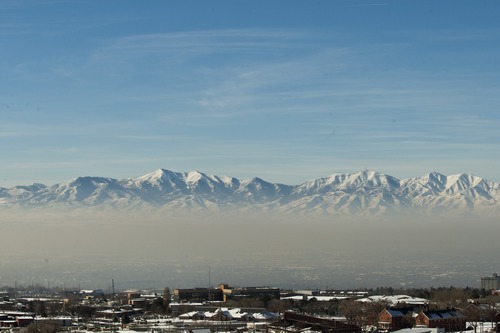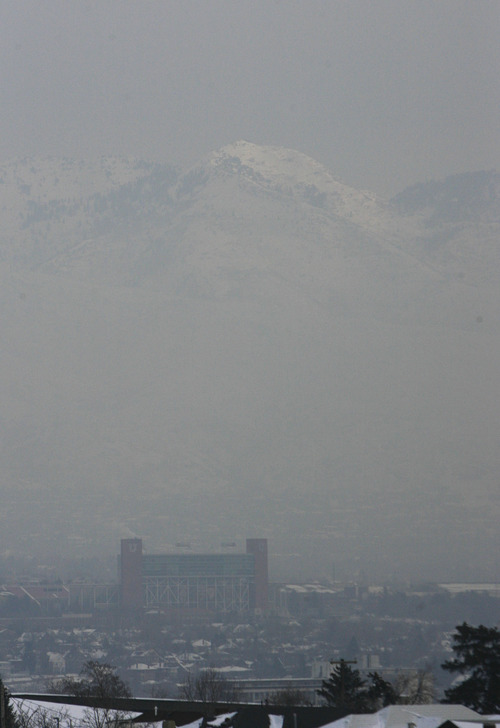This is an archived article that was published on sltrib.com in 2013, and information in the article may be outdated. It is provided only for personal research purposes and may not be reprinted.
The glass cleaner you squirt on your windows next year will be doing more for your clear view outside than you know.
The spray will contain less pollution-causing chemicals if state regulators have their way, as will hundreds of other cleaning products, solvents, adhesives, personal-care products and other chemicals. Low-fume consumer products are part of the latest proposal to help solve northern Utah's winter smog problem.
"There is no silver bullet," said Dave McNeill, who leads the Division of Air Quality scientists looking for solutions.
"But we are trying to look at every single possible control we can get for these three pollutants" that make up the smog, said Patrick Barickman, a scientist on the team.
The division is on a quest to cut pollution in places where winter smog spikes too often to unhealthy levels. The U.S. Environmental Protection Agency is requiring states to solve their PM 2.5 pollution problems by 2014, but Utah's regulators haven't succeeded yet in bringing projected pollution in line — even with a five-year extension.
Since December, when they missed EPA's deadline for pollution-reduction plans for Utah and Salt Lake counties, air-quality scientists have pored over the emissions tally in search of more ways to cut winter smog pollutants — volatile organic compounds (VOCs), nitrogen oxides and PM 2.5 microscopic soot from fuel burning.
The EPA's health-based limit is 35 micrograms of PM 2.5 per cubic meter of air. Already this year the Salt Lake Valley has exceeded that standard 22 times, and Utah has stood out for weeks as the nation's ugly hotspot for pollution.
The public is clamoring for an end to the irritation and health damage caused by this winter's smog. Business leaders fear affected areas will be cut off from federal highway funds and that construction constraints loom if the problem isn't solved.
Meanwhile, nothing can be done about two sources of Utah's air-quality woes — weather and geography. So, air-quality scientists must focus on the one factor that can be controlled — pollution.
Wood- and coal-burning bans are already in place throughout the seven-county pollution-control area on "red," mandatory action days. Industrial grills have to capture grease, big bakeries must reduce emissions, and smokestack industries must pare another 5 percent off their releases.
With a new summer deadline to finalize PM 2.5 plans, the state must cut still more emissions.
On transportation, responsible for at least half of the winter smog, the state hopes to encourage companies to reduce fleet idling, boost carpooling, support telecommuting and eye other strategies for easing pollution on mandatory action days.
Another possibility: reduced emissions from off-road diesel engines, such as construction equipment and farm machinery. Cleaner diesel fuels have already helped reduce this type of pollution, but air-quality scientists wonder if new idling guidelines or retrofits can help reduce pollution from this area even more.
"The timing is right," said McNeill, "to have these discussions."
On the lower-fume consumer products, air-quality officials doubt Utahns will notice any differences. These low-VOC products are already sold in 38 states that have adopted model regulations from the Consumer Product Specialty Association, the Personal Care Products Council and the American Coatings Association.
Meanwhile, the switch is expected to have a big impact on Utah's smog problems, thanks to an estimated 8,000-ton-a-year cut throughout northern Utah. With the new regulation, current emissions from these kinds of products would be halved.
The Environmental Working Group, which publishes ratings for household-cleaning chemicals and personal-care products, notes that updated formulations are less hazardous for the air both outside and indoors.
"It's really important if you have someone with respiratory disease in the house," said Sonya Lunder, a senior analyst with the watchdog group.
And she notes: "You can still buy all the mainstream products in California" where low-VOC laws were pioneered.
Twitter: @judyfutah —
Cutting pollution from consumer products
The Utah Air Quality Board plans to consider a proposed regulation on low-fume consumer products at its Wednesday meeting to help reduce outside pollution. These products would not be banned under the proposal. Instead, companies that want to sell their personal-care products, household cleaners, auto chemicals and paints in Utah would be required to offer only their low-VOC versions, formulations already in use in 38 states.
Utah air regulator Dave McNeill noted no one will be knocking on homeowners' doors in search of chemicals to confiscate. "It's not regulating what people use in their homes," he said. "What it's regulating is what can be sold in the state." —
Low-VOC products
What might be affected by Utah's proposed low-VOC regulation?
Beginning next year, consumer product companies would be required to offer formulations of their product that have reduced levels of pollution-causing volatile organic compounds.
The list of affected products includes brake and tire cleaners, adhesive and varnish removers, as well as paint-roller wash and stripper. It will affect glass, wood and spot cleaners; moth balls and liquid wrench toilet cleaner and disinfectants; deodorants, hair gels and sprays might also be affected.
O See complete listing of the consumer products included in Utah's proposed pollution-reduction regulation > http://1.usa.gov/VAl8hj





